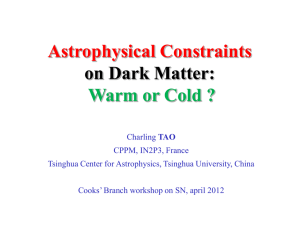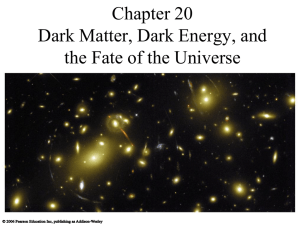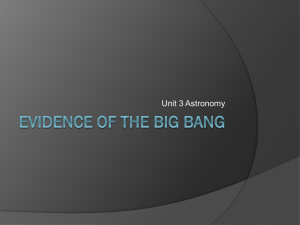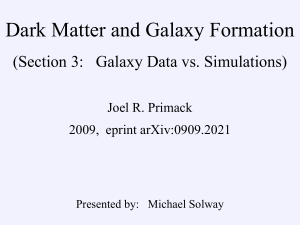ppt - IN2P3
advertisement
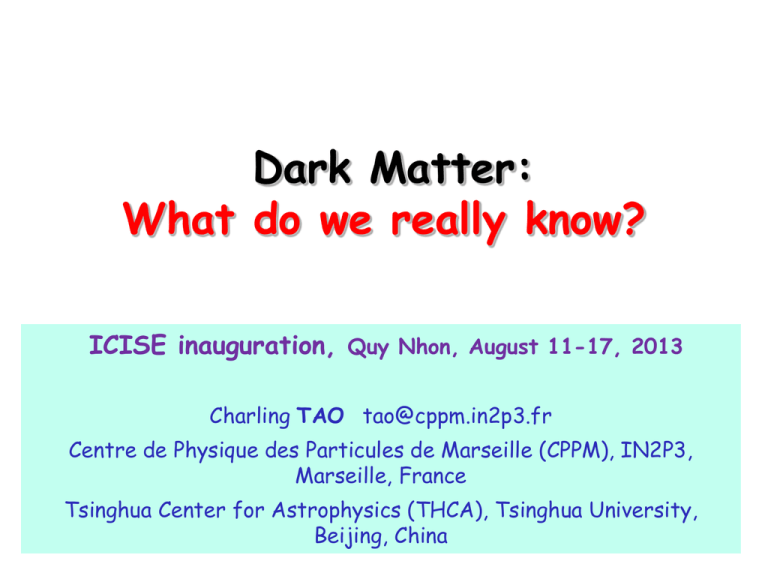
Dark Matter: What do we really know? ICISE inauguration, Quy Nhon, August 11-17, 2013 Charling TAO tao@cppm.in2p3.fr Centre de Physique des Particules de Marseille (CPPM), IN2P3, Marseille, France Tsinghua Center for Astrophysics (THCA), Tsinghua University, Beijing, China Dark Matter: What do we really know? DM: - particle that does not emit observable radiation - interacts gravitationally… - non baryonic DM: we know it exists in the Universe! Assuming standard Big bang Cosmology with GR Wealth of astrophysical evidence for DM Galaxy rotation curves (V. Rubin) Dynamics of galaxy clusters (Zwicky) X-ray clusters Bullet cluster (Clowe+,2006) Gravitational lensing mass reconstruction Evidence for dark matter: clusters Zwicky ApJ 86 ,217 (1937): Coma Cluster velocities Clusters velocity dispersion 4 masses ~ 100 x visible mass Galactic level: (!930’s) Oort discrepancy in the Milky Way April 18, 20015 disk: factor 2 now disappeared Evidence for dark matter: rotation curves of spiral galaxies V. Rubin 1970’s A.Bosma Some numbers ... A galaxy like the Milky Way or Andromeda has a total visible mass of about 61010 Msun. - rotation velocity is ~220 km/sec - radius about ~30 kpc Newton: 2 vrot R GM vrot M R G total mass: 3.31011 Msun ~5 times more mass than visible Local density 0.3- 0.4 GeV/cm3 Evidence for dark matter: Gravitational Lensing: Gravitational Lensing: a property of General Relativity Perfectly Aligned Slightly Misaligned GR: light trajectory bent by a gravitational field. Evidence for dark matter: Bullet Cluster Clowe+ 2006 X-ray vs gravitational lensing: Gaz clearly separated from mass potential peaks Dark Matter: What do we really know? DM: - particle that does not emit observable radiation - interacts gravitationally… - non baryonic DM common paradigm: it exists! - Contributes to energy density in the Universe, - Measured in clusters and galaxies The Universe energy density content after Planck % precision Cf Y. Giraud-Heraud‘s talk Wikipedia Matter today ~ 31.7% energy density of the Universe 84.5% of the matter is dark matter What do we know about DM nature ? Particle : stable? mass? interaction cross-sections? charge? spin ? Constraints from non-observation in direct/indirect/LHC searches AND Observations in Astrophysics / Cosmology Very different DM candidates Modified Gravity dust Cold Molecular Hydrogen MACHOs Black holes SIMPs 1Neutrino 3. Light axions Exotica 2. WIMPs Weakly interacting massive particles 10-1000GeV Snowmass 2013 Why WIMPs? “WIMP”= “Weakly Interacting” Massive Particles G. Altarelli: « still most optimal candidates !» Arguments in the 1980’s: • Need for Cold Dark Matter from Large Scale Structures • Very good Particle physics candidate: SUSY LSP • Weak neutrino size cross sections expected which our detectors Ge, NaI were sensitive to… Why WIMPs? “WIMP”= “Weakly Interacting” Massive Particles Assumption: DM= Relic Particles from Big Bang If DM survives today rate annihilation < rate expansion If (rate annihilation << rate expansion), too much DM today At « freeze out » < s v > ~ 10-26/ W h2 cm3/s Scale of weak interactions ! Coincidence with W, Z physics? Argument in 80’s, now weaker? Searches for massive neutrinos cross sections exclude cross-section < 0.1 sn Particle physics preferred DM: SUSY Neutralinos ? • A natural particle physics solution • Stable linear combination gauginos and higgsinos (LSP) 0 0 ˜ ˜ ˜ ˜ Z H1 H2 • SUSY > 7 parameters MSSM no predictive power • Experimental Constraints LEP, pp, b-->s,LHC ... Look everywhere possible ! Direct and Indirect Detections WIMP searches Direct detection M Indirect detection MN Ge, Si, NaI, LXe, … Accelerator particle production, eg, LHC + Galactic, cluster, Universe scales… n,,p, e+ Indirect Detection: Principle SMMG Sun, Earth, Accumulation Galactic center, + clumps? n Annihilation Possible final states: t+t-, lepton pairs, qq, WH, ZH, WW, ZZ ; Hadronisation and decay Astroparticle detectors: positrons, antiprotons, antideutons gammas, neutrinos Astrophysical of observed Non dedicatedorigin experiments signals,eg, AMS, are hard to exclude (cf Lee SC’s talk) Need discovery at accelerators! Still hope at LHC ? WIMPs Indirect Detection - e+ n,,p, Shore station Light Sources K40 Bioluminescence Optical M odules track hydrophone Cerenkov Light ~60m float Compass, tilt meter 2500m Electro-optical underwater cable ~40km 300m Electronics Containers Readout Cables 50m anchor Junction box acoustic detector Present limits Neutrino limit: Billard+ 2013 Snowmass 2013 WIMP search: direct detection Cf. B. Sadoulet’s talk Usual assumptions of DM distribution in our Galaxy Usual h y p othesis DM= 0.3 GeV/cm 3 , =10 -3 , Maxwellian distribution of velocities, vrms =270 km/s Rotation curves c (r ) (r ) (r / a) (1 (r / a) ) ( ) / ? a = halo core radius Isothermal profile 2 2 0 =0 without cusp vSun=220 km /s Navarro-Frenk-White 1 3 1 « Simplified Model »of Matter in our Galaxy: SMMG Mo Moore + 1.5 3 1.5) Used for most comparisons… But is it the reality? Clumps? Corotation? Galactic scale N-body simulations with Baryons Ling+ 2009 Dark Matter Direct Detection Signals inferred from a Cosmological N-body Simulation with Baryons Fin 2 DM populations : halo DM +disk DM only measurements can tell LCDM simulation at small scales might have problems DM properties from Large Scale Structures LSS Cf beautiful movies of G. Smoot Planck CMB map Primordial perturbation seeds for structure formation DM potential wells Structure formation: Bottom-up Scenario !Density perturbations collapse into DM haloes. Small Haloes merge into bigger haloes. Gas in DM haloes collapse in galactic disks. Shapes of galaxies change over time. Due to merging of haloes Hubble Tuning Fork Diagram Before 2000: Nature of DM Hot or Cold? CDM is non-relativistic at decoupling, Form structures in a Hierarchical bottom-up scenario. HDM relativistic at decoupling Mean free path large Large structures form first Comparisons of observations with pre-2000 N-body Simulations prefer CDM Z=3 Z=1 Z=0 OMEGA = 0.3 LAMBDA = 0.7 H0 = 70 km/(Mpc sec) Sigma8 = 0.9 LCDM OMEGA = 1 LAMBDASCDM =0 H0 = 50 km/(Mpc sec) Sigma8 =tCDM 0.51 OMEGA = 0.3 LAMBDAOCDM =0 H0 = 50 km/(Mpc sec) Sigma8 = 0.51 OMEGA = 0.3 LAMBDA = 0 H0 = 70 km/(Mpc sec) Sigma8 = 0.85 Collaboration VIRGO 1996 http://www.mpa-garching.mpg.de/~virgo/virgo/ N-Body simulations: CDM Preferred paradigm: Most N-Body simulations use stable CDM halos as seed for structures: structures evolve, merge and cluster - DM halos - cuspy density profiles, - Triaxial halos - central density depends on the mass of the halo. Dark matter distribution—Density profiles Cusp Universal Density Profile from N-body simulations NFW Navarro, Frenk, White 1996 Cluster central density profile X-ray ~2000 : CDM crisis at small scales Comparing data with N-body Simulations •cusp/core at GC •Missing galactic satellites Galaxy profiles prefer core at center CDM Simulations cusps (Navarro, Frenk, White 1996): Problems at smaller scales? Observations favour Core profile rotation curves Galaxy core vs cusp Salucci & Frigerio Martins, 2009 Data prefer Burkert Core Profile Too low number of visible Satellite galaxies Satellite galaxies are seen in Milky Way, e.g. Saggittarius, MCs Predicted number Observed number of luminous satellite galaxies 10km/s 20km/s 100km/s Alternatives to CDM • Self-Interacting Dark Matter (Spergel & Steinhardt 2000) • Strongly Interacting Massive Particle • Annihilating DM • Decaying DM (eg. Zhang XM+, Nguyen Quynh Lan in // session) • … • WDM: reduce the small scale power Norma G.Sanchez, Hector J. de Vega+… Chalonge series DM Self-interaction constraints DM particles might interact with themselves or other new particles, mediated by new, dark gauge bosons. Interactions affect the structures of DM halos: DM scatters energy and angular momentum transfers For hard-sphere elastic scattering, observations of the structure of galaxy clusters constraints σ /m 4.5 E-7 (t/E10 yr)-2 < s/m <~ 1 cm2/g Bullet cluster Williams & Saha 2011 SL cluster analysis < 0.02 elliptical core MS2137-23 Miralda-Escude 2002 Non neutral DM/CHAMPs Strong constraints : Charged (CHAMPS) or small electric or magnetic dipole moment coupling to the photon-baryon fluid before recombination, alter the sub-degree-scale of CMB and matter power spectrum. Cf - Sigurdson+ , Dark-matter electric and magnetic dipole moments, (2004); - McDermott, H.-B. Yu, & K. M. Zurek, Turning off the lights: How dark is dark matter? (2011) “Evidence” for WDM ? •"missing satellite problem'', •''cusp-core problem'', • mini-voids The sizes of mini-voids in the local universe: an argument in favor of a warm dark matter model? Tikhonov et al. •HI determinations of velocity function profiles N-Body simulation Comparisons with Virgo results by Arecibo Legacy (ALFALFA) N-Body simulations: WDM Stable WDM looks like stable CDM on scales> 10 Mpc, - WDM create a cutoff in the matter power spectrum At late times, the evolution of the matter power spectrum is more subtle as halos form. Large WDM halos are virtually indistinguishable from stable CDM halos somewhat less concentrated, smaller halos, fluffier and less cuspy than CDM halos. The subhalo mass function drops significantly on mass scales corresponding to that cutoff scale. Does not solve everything Nature of DM Hot or Cold, or Warm? CDM is non-relativistic at decoupling, forms structures in a hierarchical, bottom-up scenario. HDM is tightly bound by observations and LSS formation WDM 10 h/Mpc, keV WDM? CLUES simulations, Yepes, 2010 WDM vs CDM Velocity function Density profile From Jing 2000 CDM vs WDM: HI velocity functions Virgo and Anti Virgo directions arXiv:1005.2687: Constrained Local UniversE Simulations (CLUES) Gottloeber, Hoffman , Yepes No simple feedback mechanism to explain the factor 10 depletion from CDM? Velocity widths in Galaxies Velocity widths in galaxies from 21 cm HI surveys Papastergis et al, 2011; Zavala et al., 2009 NB: The red curve is for 1 keV WDM Limits on mass of eventual WDM particles • Stellar dynamics in MW satellites (Boyanovsky, de Vega, Sanchez 2008; de Vega and Sanchez 2009) • High-z QSO LF (e.g. Song and Lee 2009) • Ly-alpha forest to constrain P(k) at small scales and different z’s (Most popular method: Narayanan et al 2000; Viel et al 2005;2008) • Ly-a + SDSS results (Boyarsky et al 2009) • QSO lensing ( Miranda & Maccio 2007 ) • Abundance of dwarf satellites of MW (Maccio & Fontanot 2010; Polysensky & Ricotti, 2010) Mass WDM ~ 1- 5 keV A fashionable (?) candidate Sterile neutrinos Constraints on sterile neutrinos ~2000 :Problems with CDM at small scales Comparing data with N-body Simulations • Galactic satellites • cusp/core at GC Problems can perhaps be solved with better resolution and additional physics in N-Body simulations (SN, AGN feedback, stellar winds…) Einasto vs NFW CDM Simulations cusps rather Einasto profiles than NFW Ma Chung Pei, Chang, P., Zhang, 2009 Missing satellites: CDM way out • satellites do exist, but star formation suppressed (after reionization?) • satellites orbit do not bring them to close interaction with disk, so they will not heat up the disk. • Local Group dwarf velocity dispersion underestimated • Galaxies may not follow dwarves Halo substructures may be probed by - Lensing - local Milky Way structures More faint or dark galaxies discovered Eg, Belokurov et al, 2010 Nature of dark matter or astrophysics process? What we know: Comparisons of observations with N-body Simulations today prefer Non-Hot DM Probing DM Particle properties CL0024 Mandelbaum et al. (2006) Tyson, Kochanski, & Dell’Antonio (1998) Stacked galaxy—galaxy weak lensing signal fit with various profiles. 12/16/2009 70 Progress in Gravitational Lensing • Strong lensing arclets • Weak lensing • Flexion “Weak Lensing” Distorsion of galaxy shapes by foreground matter without lensing Lensing effect Weak Lensing mass reconstruction Image ellipticity -> shear-> invert the equation RXJ1347.5-1145 (Bradac et al 2005) Galaxy-scale DM density profile Generalized NFW model → Dark Matter mass Sensitivity of detection scales by lensing Weak lensing: Flexion: Strong lensing: < 100 kpc 10-100 kpc 1-10 kpc Surface density profile measurements obtained from galaxy groups in the COSMOS survey Leauthaud et al. 2010 Dec 2012 Galaxy-galaxy lensing Measure the correlation of shear of the background galaxies with mass of the foreground galaxies To achieve the galaxy-galaxy lensing signal, we need two important ingredients that we can extract from the data 1)redshift distribution of the lensed background galaxies 2)shape of the lensed background galaxies Future Measurements of DM properties with lensing From 100 sq deg scale at CFHT to 5000 – 20000 sq deg sky surveys KDUST? WFIRST? BigBoss-like/MS-DESI can provide 3D Euclid slide + new logo Cosmic shear power spectra Markovic et al. 2010 Euclid-like DE space survey +Planck: Integral effects → better than matter power spectrum Sensitive to m_WDM < 2.5 keV keV WDM effect around k=10 h/Mpc Issues • Galaxy evolution alters DM halos and the matter power spectrum . Rudd, Zentner & Kravtsov, Effects of Baryons and Dissipation on the Matter Power Spectrum (2008); Pedrosa,Tissera, & Scannapieco, The joint evolution of baryons and dark matter halos, (2010); Scannapieco +, The Aquila Comparison Project: The Effects of Feedback and Numerical Methods on Simulations of Galaxy Formation, arXiv:1112.0315. • Most of the simulations (even today) are DM-only - DM halos extremely sensitive to the implementation of the galaxy physics in the codes. - DM halo morphologies and galaxy properties need resolutions: giant molecular cloud (GMC) sized regions . But a lot of concern/work in the last 3 years. N-Body simulations with baryons Jing Y. (2005) More recent comparisons of WDM and CDM simulations. eg Gao+, Jing+ , Yepes+ , - Non-linear collapse of WDM structures Caveat: Strong Reliance on N-body simulations might be misleading! Baryon physics (eg.,AGN feedback) affects Matter Power Spectrum Semboloni+ (2011) Van Daalen+(2011) Shale + :OWLS simulation Consequences on WL cosmological parameters fits Baryon effects different from neutrino effects Semboloni et al. 2011 Dark Matter: What do we really know? DM: - particles that does not emit observable radiation - interacts gravitationally… - non baryonic DM: we know it exists! Or Do We Really? Alternatives to DM? Not so many models any more, but still… some are still doubting: eg http://www.astro.uni-bonn.de/~pavel/kroupa_SciLogs.html Famaey & Mc Gaugh Living Reviews in Relativity, vol. 15, no. 10 2012 - MOND- Milgrom /TEVES-Beckenstein needs neutrinos to explain Bullet Cluster… - MOG : Moffat and collaborators Scalar-Tensor-Vector Model of gravity : “few parameters can explain away DE and DM”. Main observational argument for alternative to DM Local Universe: - Velocity analysis local density ~ 0.07-0.08 - Dwarf galaxies: observed ones seem to be Tidal dwarf galaxies not expected to be dominant with DM models but seem to be observationnally in disk of Milky Way and Andromeda How representative is it? Universe with Torsion - Extension to GR: in simplest CARTAN model : (eg, Schucker and Tilquin) Lambda/DE still needed but… DM reduced (to zero?) - Difficulties with many extensions eg Gauss theorem not valid, pathologies… Summary: What do we know about DM? • Astrophysical observations existence of non baryonic Dark Matter • N-Body simulations and Observations of LSS existence of not-hot DM? . Many problems with CDM simulations can be solved with O(1keV) WDM or Baryon physics ? • More work on baryonic N-body simulations needed! We love CDM but need to find CDM in accelerators and DD/ID experiments! A mysterious Dark Universe ! What we know is only 4-5 % of the energy density of the Universe We now measure with precision the extent of our ignorance ! Graph source: Wikipedia cảm ơn bạn Thank you 谢谢 Towards a large South Pole Dome A Kunlun Dark Universe Survey Telescope (KDUST) Multiprobe measurements (SNIa, Weak Lensing, BAO, Clusters) for cosmology and ancillary science First stage 2011-2015: 3 x 67 cms telescopes (AST3) - one AST3 installed in Dome A in fall 2011, THCA contributes to one AST3 and take responsibility for SN search (need computing capability) - Collaboration with Australia, US and France 2.5 m KPATH (Kunlun Pathfinder): 2013(?)-2017 Larger (> 4m) KDUST: Timescale too early to define! Antarctica Schmidt Telescopes (AST3) Aperture:67 cm; FOV:4.2°; Wave Band:400nm-900nm ( i,g, r, or IR? filter for 3 telescopes ); Scale:1 arcsec/pixel; Image quality:80%energy encircled in one pixel; CCD: 9micron /pixel, 10580x10560 (95.22mm x 95.05mm image area); Type: STA1600; Working mode: frame transfer readout Focal length: 1867mm Distorsion in the whole field: 0.012% (less than 1 pixel) Total optical length: 2.2m First AST3 in Dome A, some data in 2012 Summer 2011 in Xuyu Dec 2011 in Dome A The Kunlun Dark Universe Survey Telescope 5000 sq deg down to mag 29

